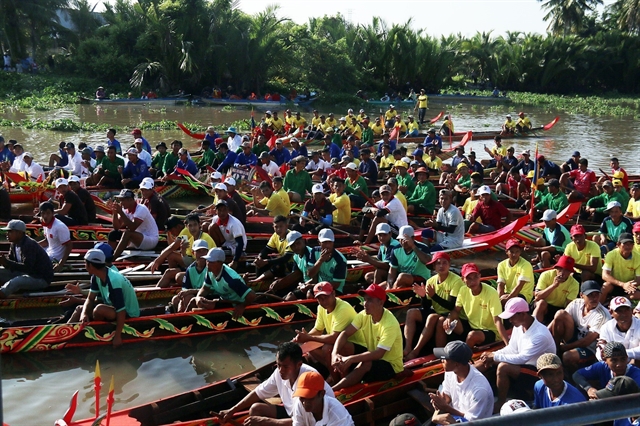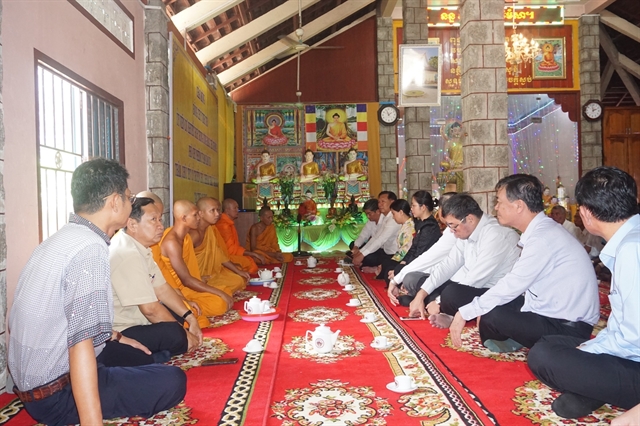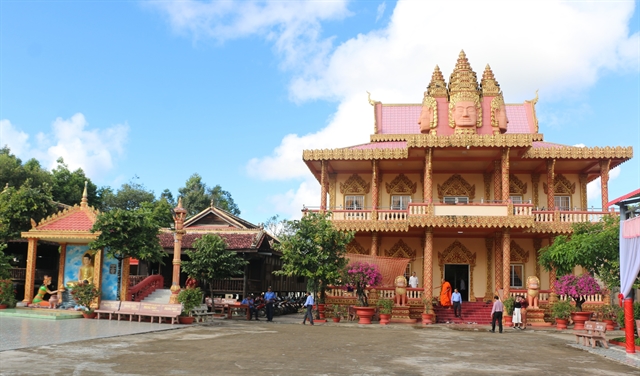 Society
Society


|
| A boat race is held to celebrate Chôl Chnăm Thmây in Châu Thành District in Kiên Giang. VNA/VNS Photo Lê Sen |
KIÊN GIANG — Khmer ethnic group people are about to celebrate their biggest holiday of the year, Chôl Chnăm Thmây, their traditional New Year festival, which will be held from April 14-16.
The Khmer community in the southern province of Kiên Giang are in festive spirits as their holiday draws near.
This year, Danh Ngươn and his family in Định Hòa Commune in Gò Quao District will have a bigger celebration than in previous years as all his children and grandchildren will be returning home to celebrate the holiday.
His family members are busy ensuring the reunion is filled with love.
Making bánh tét (a traditional cylindrical-shaped dish made from glutinous rice, mung bean and pork), which will be used as gifts for relatives and placed on the ancestral altar as an offering during the holiday, is an indispensable part of the preparation.
Ngươn said this is a time to cherish reunions after a year of hard work and an occasion to remind children and grandchildren of the fine long-standing customs and their responsibility of preserving them.
With over 13 per cent of its population being Khmer people (238,000 people), Kiên Giang is home to the third largest Khmer community in the Mekong Delta, after Sóc Trăng and Trà Vinh provinces.
Danh Út, a resident in Bình Lợi Hamlet of Minh Hòa Commune, noted Khmer people have never celebrated the traditional New Year festival as joyfully as this year.

|
| A working delegation of the Committee for Ethnic Minority Affairs visits the Khmer community in An Giang Province ahead of the celebration. VNA/VNS Photo Thanh Sang |
Chôl Chnăm Thmây is an occasion for the younger generations to learn about filial piety, meet relatives and friends, exchange greetings, review achievements in a year, and encourage charitable work.
Traditionally, people visit pagodas to offer flowers and prayers to the Buddha on the first day of the New Year and then engage in festive activities, including folk singing and dancing.
Danh Phúc, head of the Kiên Giang board for ethnic minority affairs, said to welcome the festival, the board has coordinated with relevant agencies and localities to organise such activities as holding gatherings with monks, retired cadres, martyrs’ families, war invalids, revolution contributors, and reputable persons in the community, and visiting and presenting gifts to the provincial Association for Solidarity of Patriotic Monks, Khmer pagodas, boarding schools for ethnic minority students, and disadvantaged families.
He said that despite difficulties caused by the COVID-19 pandemic, local Khmer people have still benefited from better life quality.

|
| Pagodas are considered a centre of religious and cultural activities, a place to practise the morality and virtue of the Khmer people. VNA/VNS Photo Tuấn Kiệt |
Phúc highlighted improvements in education and health care, stable political security and social order and safety, and enhanced solidarity among ethnic groups.
He attributed those attainments partly to the timely implementation of programmes, projects, and policies on ethnic minorities, along with people’s consensus and adherence to the Party’s guidelines and the State’s laws.
As a result, many households have succeeded in developing production and business, helping to alleviate poverty in the Khmer community.
Under the multidimensional approach, the household poverty rate among local ethnic minority groups has been brought down to 3.68 per cent and the rate of near-poor households is down to nearly 6 per cent, according to the official.
Joyful celebration thanks to improved life
Lưu Minh Ly, a resident of Thuận Hoà Commune in Châu Thành District, Sóc Trăng Province, will also have a bigger New Year celebration, and his family's life has gradually improved.
The family’s income has improved thanks to the support of the authority. As a poor family with no agricultural land, he received VNĐ10 million from the job change support programme in 2022 and was given financial support to buy a sprayer and a lawn mower, and to build a house.
He can now find more jobs and earns an average of VNĐ200,000 a day, which helps improve his family's life.
According to Hồ Thị Cẩm Đào, Standing Deputy Secretary of the Provincial Party Committee, Chairwoman of the People's Council of Sóc Trăng, the province has always paid attention to the socio-economic development of the province in general and the ethnic minority groups in particular.
It has implemented measures related to social security, healthcare, education training and human resource development, among many others.
The province receives hundreds of billions of đồng from the government to invest in ethnic minority areas. This helps the locality to bring positive impacts in many fields. — VNS
Facts about Khmer ethnic minority group in Việt Nam History: Many studies have confirmed that the Khmer people in Việt Nam are descendants of immigrants from the Chenla Kingdom, a Khmer civilisation considered to be the predecessor of the Khmer empire at Angkor. They migrated to this area in waves for a variety of reasons. Along with the Vietnamese and the Chinese, the Khmer were among the earliest populations in the Mekong Delta. Language: The Khmer people speak Khmer - a language belonging to the Mon-Khmer group in the Austroasiatic language family. Geographical distribution: Khmer people mostly live in Trà Vinh, Sóc Trăng, Kiên Giang, An Giang, Bạc Liêu, Cần Thơ and Vĩnh Long in the Mekong Delta region. Population: As of 2019, the total population of Khmer was more than 1.3 million people. The average household size is 3.7 people, while the percentage of the population living in rural areas at 76.5 per cent. Festivals: The Khmer people have a rich cultural and spiritual life. Among the festivals celebrated, Chôl Chnăm Thmây (a festival expressing the wish for a new year of favourable rain and wind, and bountiful crops) and Ok-ang Bok Festival (moon worshipping ceremony) are the two major festivals of the year. Traditional social institutions: The Khmer people in the Mekong Delta live in hamlets called phum (consisting of three to eight small families with kinship relationships), and villages called sóc (traditional self-governing social institutions). Blood relations and marriage are two of the basic relationships in phum, while neighbourly, territorial relations mixed with close kinship are the basic relationships in sóc. Religion and belief: Most Khmer people in Việt Nam are followers of Theravada Buddhism. Buddhism plays a particularly important role in the spiritual lives of the Khmer. The teachings and commandments of Buddhism have become the norm in relations among the Khmer in sóc. Education: As of 2019, the percentage of Khmer people aged 15 years and over who can read and write generally is 76.7 per cent, and the proportion of out-of-school children is 23.4 per cent. In recent years, the issue of education development for the Khmer people has been given special attention by the State and local authorities at all levels and sectors. Sources: The Committee on Ethnic Minority Affairs, the General Statistics Office, the Committee on Ethnic Minority Affairs and Nhân Dân (People) newspaper. |




